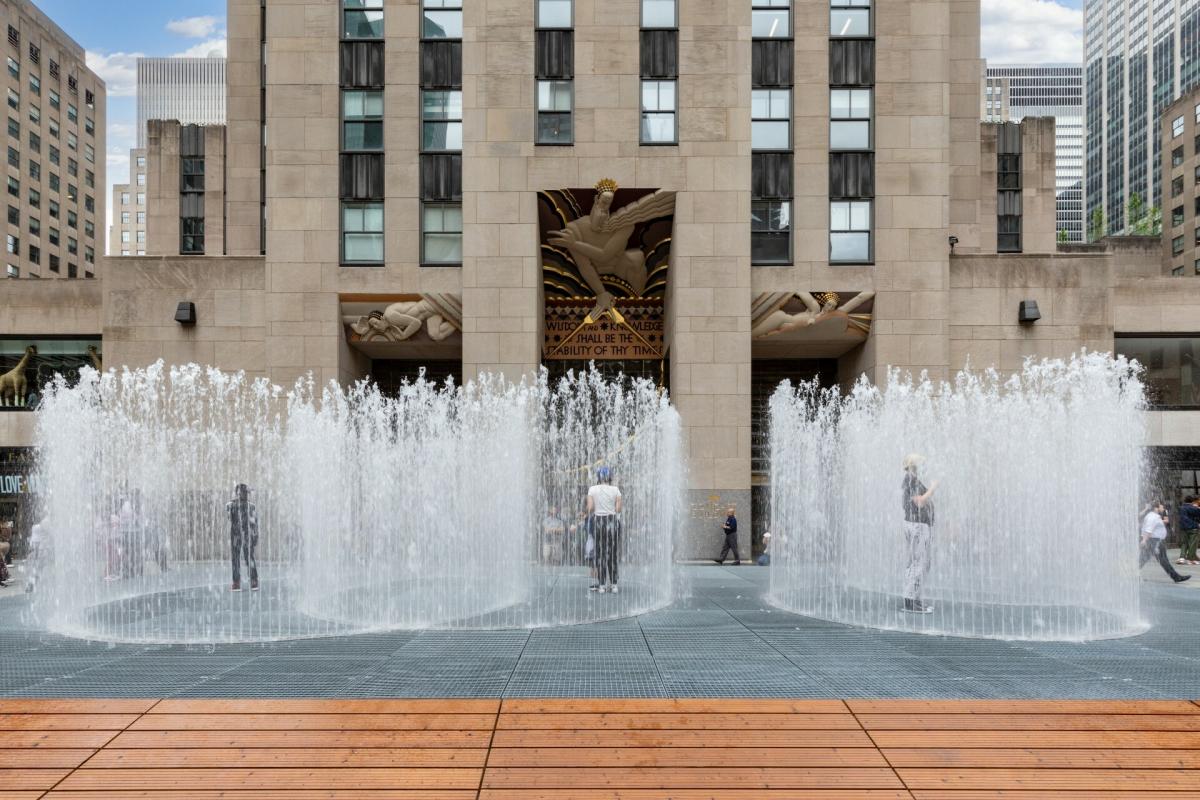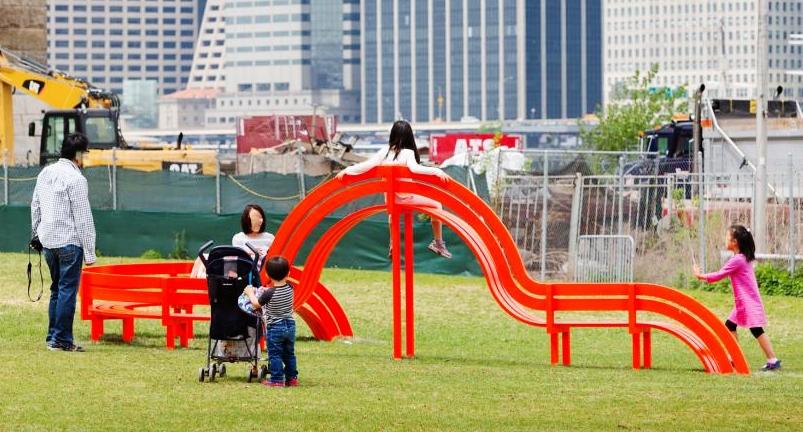Jeppe Heim (b.1974, Copenhagen, Denmark) is an artist who believes viewers should touch the art. He was trained at the Royal Danish Academy of Art (1997-2003), and in 2009-10, he completed a residency at the Alexander Calder studio in Sache, France. Where ever his work is shown, in outdoor sculpture installations or inside on walls, his works invite viewers to participate in the art in a number of sensory ways.
“Please Touch the Art” (2015) consists of Heim’s three installations in Brooklyn Bridge Park, New York City, from May 2015 through April 2016. Brooklyn Park Bridge stretches 1.24 miles along the East River from Pier 1 to Pier 6. His installations began at Pier 1. “Appearing Room” was a system of water jets with sensors that responded to the movement of people walking through the space. Seven-foot-high columns of water shot upward at staggered intervals. Participants could avoid getting wet if they wanted to, but why would anyone want to miss out on the fun. When Heim introduced “Appearing Room” at the 2003 Venice Biennale, it attracted the largest crowds of any of the Biennale exhibits. According to Heim, “If you’re creating a smile in yourself and also giving it to someone else, then you’ve started a dialogue. You also start to play.”
Heim’s second installation “Mirror Labyrinth” was at Pier 3 on Greenway Terrace. Heim’s piece was designed to work with the natural landscape and the view of Lower Manhattan. Mirror-polished stainless-steel posts were installed in three arcs to create a labyrinth path through which viewers could walk. The labyrinth appears in Greek mythology. Daedalus built a labyrinth for King Minos of Crete to contain the dangerous Minotaur. Heim intended his “Mirror Labyrinth,” light and airy, to create a sense of wonder, of adventure, and happiness. He hoped the unexpected encounters with other visitors would encourage dialogue. The mirrors changed the viewers’ perspectives of the Manhattan skyline as it interacted with the green lawn. Heim commented on his use of mirrors: “…people reflect themselves in the work and [it] becomes a tool for communication and dialogue.”
Sixteen different “Modified Social Benches,” painted in bright red, created unique places to sit and enjoy the scenery, the day, and people in Brooklyn Bridge Park. The benches encouraged children to climb and slide, and adults to rest, read, and talk.
Heim created “A New End” for the area known as World’s End, a 251-acre park in Hingham, Massachusetts, one hour south of Boston. The park consists of four spoon shaped hills that connect two islands with a man-made sandbar. Designed by the American architect Frederick Law Olmsted in 1890, the park includes rolling hills, a rocky shoreline, open fields, and a tree-lined carriage path, all with a beautiful view of the Boston Harbor. In 1996, it became part of the Boston Islands National Recreation Area, including trails for walking and horseback riding, and cross-country skiing in winter. Heim said, “I had to find out what people used this place for…I was inspired by that.” He also talked about “A New End” as a title: “I think the name “World’s End” is really interesting. What is it? What is the world’s end? Where? I don’t believe in ends. I think that when something ends there’s something new starting. The name was to inspire people to not believe in ends…If it’s not good, it’s not the end.”
Heim was attracted not only to the beauty of the park and the recreation opportunities it provided, but also to the park’s stillness and seclusion. Heim practices yoga, and he believes that dialogue with oneself and with others is essential to a good life. He chose a mirror labyrinth to encourage contemplation and reflection. The new site-specific labyrinth was placed at the foot of a hill where the sandbar began. The stainless-steel columns were configured in three lines to create a spiral design. Starting with three-foot columns on the outside, the columns rise to nine feet at the center. From above, the design resembles a nautilus shell. The year-long instillation, allowed the numerous park visitors to view the labyrinth in all four seasons and at all times of day and night.
Heim wants his art to encourage interaction and conversation, and contemplation and reflection: “We’re in a society, I think, where everyone thinks it’s so cool to work, it’s so cool to be online, so cool to be super busy. I think it’s super cool not to be busy.”
Heim’s “Changing Spaces,” an “Appearing Rooms” installation he now calls “liquid architecture,” currently is in Rockefeller Center’s Central Plaza (30 Rock) in New York City through September 9, 2022. He says, “My artistic approach was to invite people to make use of the work, either as a space of seclusion and relaxation or the opposite, a place of pure joy and playfulness. The shape was meant to contrast the rectangular layout of New York embracing people in a circle of water.”
Heim’s outdoor sculptures have been commissioned by the cities of London, Los Angeles, Boston, Helsinki, Miami, Cadiz, and New York, among others. “Appearing Rooms” are now permanently installed in both London and Zaragoza, Spain. His gallery exhibitions are as popular as his outdoor installations. Different from the large outdoor work, they often employ mirrors to encourage self-reflection, participation, and dialogue by viewers.
“We don’t understand each other. That’s why there are so many bad things happening… Not that I’m trying to save the world … but I try to do my part and if you can somehow engage with this art piece… If you’re creating a smile in yourself and also giving it to someone else, then you’ve started a dialogue active. I’m not politically active, but I’m saying [that] you can open up people’s understanding of themselves and others with play.”
Beverly Hall Smith was a professor of art history for 40 years. Since retiring with her husband Kurt to Chestertown in 2014, she has taught art history classes at WC-ALL. She is also an artist whose work is sometimes in exhibitions at Chestertown RiverArts and she paints sets for the Garfield Center for the Arts.










Write a Letter to the Editor on this Article
We encourage readers to offer their point of view on this article by submitting the following form. Editing is sometimes necessary and is done at the discretion of the editorial staff.